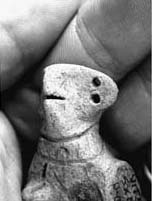Figurine worlds
A Response to Discussion Week 3: Sept. 22. Body and the archaeological discourse
Ömür Harmansah Posted: September 28, 2006. Thursday: 0:59 am.
I wanted to post some of my ideas on the figurines before we start to read performance theory: I have a feeling that my understanding of those little prehistoric creatures will change drastically as we start imagining them as miniature performing actors in the social world (yes, I do believe that’s where we will end up). I would like to say at the outset that my main problem with the large corpus of figurine scholarship has to do with the representationality of these menacing objects, a concept I tried to elucidate in my other response of the week. Figurines and their bigger brothers, the statues are usually (not always) considered as representations of some other being, spiritual, supernatural or simply human, but rarely it crosses our mind that they may have indeed been seen as uniquely powerful, potent objects in and of themselves, not because of their representational quality or role as effigy, but because of their ontological status in the context of their particular socio-symbolic world.
While Douglas Bailey’s reading of the Chalcolithic figurines of Bulgaria as individuals is compelling and well-reasoned, I have a feeling that he is replacing one representational paradigm (figurines as divinities) with another (figurines as ancestors). One admirable aspect of his argument is his contextualization of these artifacts, considering them in meaningful association with their archaeological contexts, moving away from the decontextualizing, universalist arguments such as the “mother goddess” discourse. His other major accomplishment is his sincere attempt to locate individuals of the past in the archaeological record, a noble effort which must have been applauded loudly by Lynn Meskell, as her “somatization of archaeology” article made clear. I also would like to acknowledge Bailey’s implied conclusion that figurines are interesting examples of material culture, which is intentionally used to construct cultural identities and embodied, gendered subjectivities in the social sphere. Well done. (We need to read his recent Prehistoric Figurines book, where I am sure he has revised and matured his ideas quite a bit). I will however not keep my mouth shut about my reservations of Bailey’s interpretations, and argue that figurines appear in his reconstruction still encapsulated in the Western category of “objecthood” (as opposed to human “subjecthood”), therefore not quite given much agency to affect the world around them. There might indeed have been a socio-symbolic relationship between dead individuals and the figurines, but we need not limit the representationality and the materiality of the figurines to their connection to human subjects. Alfred Gell’s theory of agency, and theories of performativity of objects/things/artifacts will clarify I hope what I mean by all of this. I will therefore postpone this discussion a bit to avoid forced conclusions and immature ideas. It should be sufficient to say at this point that figural representations of human bodies tend to establish a fascinating link between the singular body of the individual, and what we might call the social body. The making of the figurine may in fact be seen as a form of the socialization of the body, its material disposition in the pub(l)ic realm.
Ayn Ghazal’s Middle Pre-pottery Neolithic B lime plaster individuals present a challenging case for us to consider. They have been associated with ancestor veneration and mortuary rituals in relation with to skull-removal practices at the site. The removal of skulls from the graves, and their material modification though apparently symbolically charged acts such as painting, plaster mask-making etc requires attention if we are to consider the relationship between the dead and the living in PPN Ayn Ghazal. The potent material link established between the dead individual and the lived phenomenal world through the use of body parts is significant. What precisely were the ambiguously rendered, smashed and buried lime plaster statues doing is hard to hypothesize. Bailey’s model for searching individuals behind these creatures may indeed prove fruitful even though their archaeological context in caches tells us little about such individuation. The active participation of the lime plaster statues in ritual performances may be a useful line of inquiry for the future.

